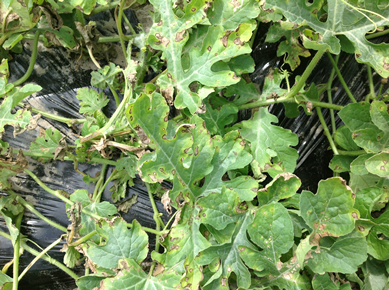Florida, USA
September 6, 2013

Symptoms of a new bacterial disease on watermelon in Florida.
Looking at Florida watermelons neatly stacked in a super market produce section hardly brings to mind a mystery worthy of Dashiell Hammett, but then a furtive, unknown disease invaded the state’s watermelon fields.
“We began to receive calls and e-mails this spring from growers and Extension Agents in Florida Counties with commercial watermelon acreage,” said Dr. Mathews Paret, plant pathologist at the UF/IFAS North Florida Research and Education Center (NFREC) in Quincy, Florida, and the investigation leader. “All the reports described an unknown disease which destroyed the leaves on these plants,” said Paret.
The key symptom is circular, black edged lesions with white to tan centers. Under the microscope a cut section of the lesions indicated heavy bacterial streaming.
To begin the identification, a Gas-Chromatography Fatty Acid Methyl Ester Analysis (FAME) and 16S DNA sequencing was conducted. Every micro-organism has a FAME profile, the equivalent of a microbial fingerprint unique to the bacteria, and 16S is a DNA analysis used to further characterize the pathogen. In addition, additional biochemical characterizations and pathogenicity tests on watermelon seedlings are currently being conducted.
Preliminary identification of the pathogen indicated Pseudomonas, a genus of gram-negative aerobic gammaproteobacteria. It is capable of colonizing a wide range of plants.
Reports from Georgia in 2003, and from California in 2006 and 2011, have identified a Pseudomonas species associated with watermelon disease as the cause of similar outbreaks. The spring 2013 occurrence is the first in Florida.
Mathews Paret, Nicholas Dufault and Carrie Harmon at the UF Plant Disease Clinic have collectively confirmed about 40 bacterial strains to date. Further sample collection and identification of the bacterium is in progress.
“Our objectives are three-fold,” said Paret. “First we want to characterize the bacterial causal agent of this new watermelon disease, then test the bacterial strains for sensitivity to copper, and lastly to test the integrated use of copper, and Systemic Acquired Resistance (SAR) inducers to manage this bacterial disease,” he said.
Paret and Dufault are leading a team of researchers, UF/IFAS Extension Agents and watermelon growers from around Florida to solve this disease mystery. Their research is funded by a grant from the Florida Watermelon Growers Association.
 Author: Les Harrison - harrisog@ufl.edu
Author: Les Harrison - harrisog@ufl.edu
Les Harrison is the UF/IFAS Wakulla County Extension Director. He began his work in the Northwest Extension District as the Sustainable Agriculture and Extension Technology Agent in Leon County on August 25, 2006. His career in agriculture extends back over thirty five years and includes work in business, government and academic positions. Prior to working with the Extension Service, he spent 16 years with the Florida Department of Agriculture and Consumer Services in the Division of Marketing and Development. He worked in four of the division's six bureaus. He has also managed farm supply cooperatives in Alabama and Virginia with annual sales over four million dollars, worked for an international grain company, and was a research associate for Auburn University’s Agricultural Economics Department. He has a Master’s of Science Degree in Agricultural Economics from Auburn University and a Bachelor of Science Degree in Journalism from the University of Florida. He is the author of over 400 publications and has written professionally for print and broadcast media.